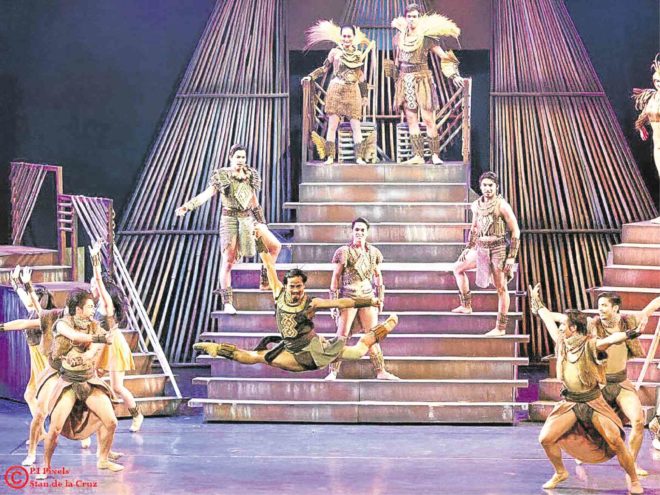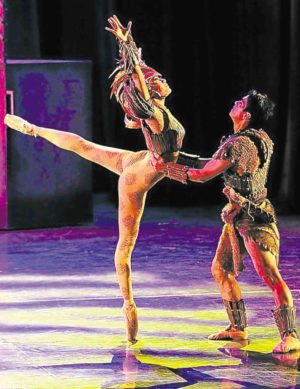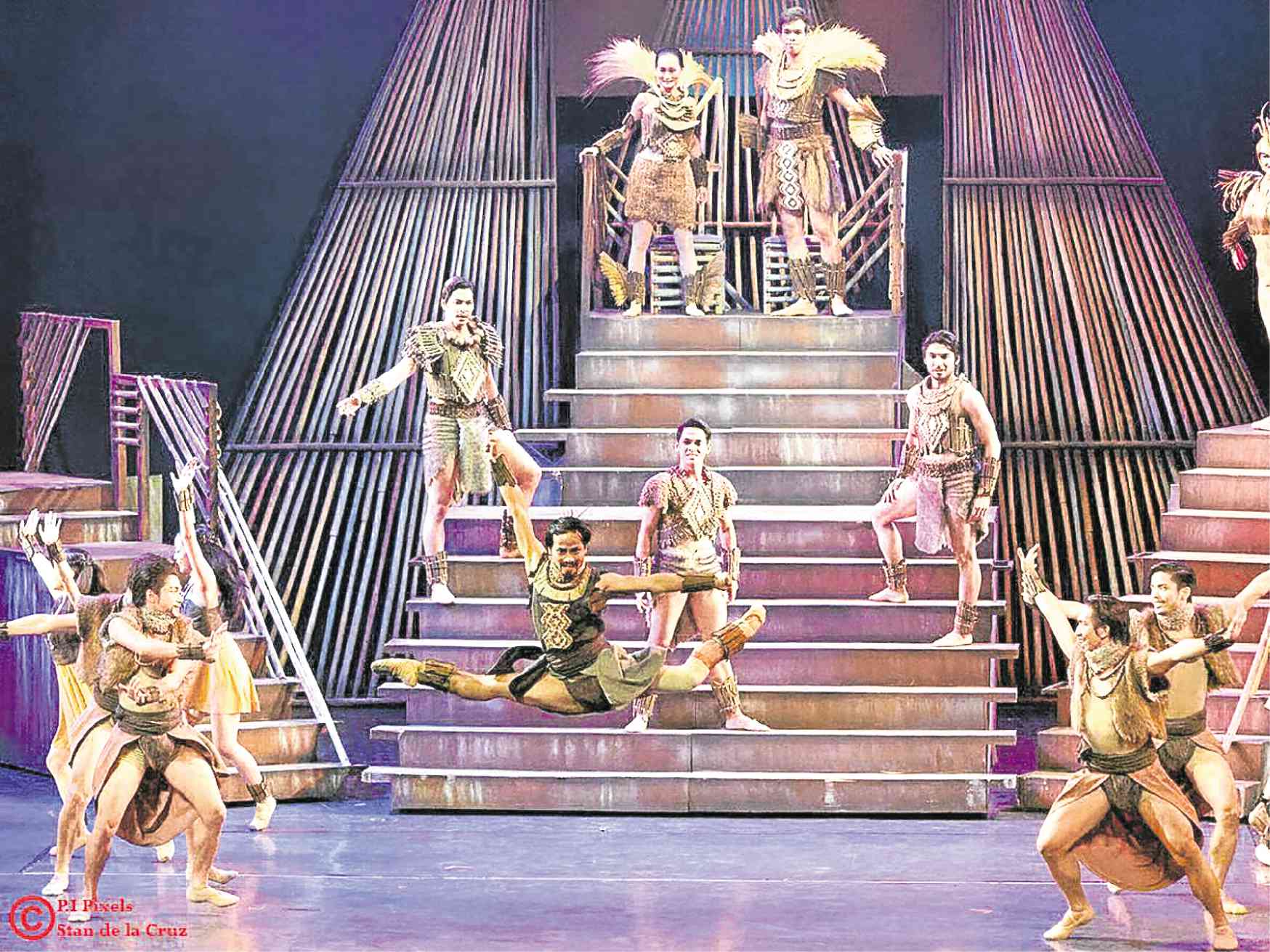
A double salvo of grand productions on two consecutive weekends marked the season openings of two of the country’s top ballet companies, Ballet Philippines and Ballet Manila.
In both productions, the quality of the dancing hardly fell short of being top form. Steady multiple pirouettes, grand jettés with high ballon that left dancers momentarily hovering in the air, clean endings in fifth.
All academic and artistic values fulfilled and more, the dancers in both companies owned the stage comfortably in their respective productions.
In Ballet Manila’s “Ibong Adarna,” the male leads and corps were a strong force. Perhaps the varied roles assigned to them lent more opportunities to excel in interpreting different characterizations, from warriors, guards and hunters to monkeys.
The male leads Elpidio Magat, Rudy de Dios, Romeo Peralta and their alternates Mark Sumaylo, Anselmo Dictado and Rudolph Capongcal were all energetic and powerful dancers.
Abigail Oliveiro’s long and well-proportioned extremities lent grace and flexibility to her interpretation of the mystical Ibong Adarna.
Triumph of choreography
This narrative ballet was a triumph of choreography for Gerardo Francisco in his first full-length work. As a resident choreographer and principal dancer of Ballet Manila, the impressive body of work Francisco has turned out in a decade culminates in “Ibong Adarna,” hopefully the beginning of more dance epics to come.
Francisco, who did the libretto as well, seems to be headed toward a forte for story ballets, for clearly, he exhibits the knack for it.
Locally, it has been some time since an original narrative dance piece thoroughly succeeded on all counts, unlike the consistent output of our dance “elders,” Tony Fabella, Tita Radaic, Vella Damian and others, including Alice Reyes herself, where storytelling in dance form then, almost came naturally.
Blame it on the times, some say, that the advent of speedy technology, sound bites and attention deficiency have caused a younger generation to think in non sequitur bullet points.
It is to the credit of the company’s artistic director, Lisa Macuja Elizalde, that the vision and creative impetus of Francisco has been nurtured. It is a gesture of reverence on Macuja-Elizalde’s part as she slowly passes on the mantle leading up to her imminent retirement.
The drawback in the production, however, were the somewhat clonky sets like the staircases-on-wheels that proved a trifle primitive or even sophomoric in the light of new-fangled ideas and technology.
The lighting design also contributed to the audience’s confused vision by liberally choosing a color palette that contrasted, rather than complemented the earth toned sets and costumes.
The music, which clearly had Eastern strains, should have been seriously taken into consideration for the costume design, which was a mix of loin cloths and animal hair coats, bark colored arm and leg bands and headdresses of unidentifiable origin.

Fortunately the wonderful dancing and choreography blurred the design deficiencies.
Glittering selection
Ballet Philippines’ “Gala” presented a glittering selection of divertissements that had been premiered in a span of 48 years. In a sense, it was a gracious acknowledgement of the accomplishments of the company’s succeeding artistic directors following the stepping down of Alice Reyes 30 years ago as the company’s cofounder and founding artistic director. (Cofounder of Ballet Philippines was premiere danseur, Eddie Elejar). This year, Reyes, now National Artist for Dance, has returned as artistic director once more to escort the company toward its 50th year.
Ballet Philippines, in contrast to Ballet Manila, has a female corps with a collective stage presence and a unified breathing pattern, in evidence particularly in the corps work in “Raymonda.” This is not to say that as a company the unison was close to impeccable.
This was a prerequisite to Damian’s “Minamahal, Sinasamba,” in which balletic athletics with unexpected lifts and innovative partnering called for perfect synchronization despite the difficult maneuvers. In the gender-specific spots, however, the female corps put up a more defined front.
A special treat came with performances of former company members and guest dancers who came specially for the “Gala”: the multi-awarded Candice Adea, in “Raymonda” Variations; Kris-Bellas Paclibar, known as the best modern dancer in the country, danced Agnes Locsin’s “Sisa”; newly minted recruits to Kiel Ballet in Germany, Jean Marc Cordero and Rita Winder, former principal and soloist of Ballet Phillipines, respectively, in Norman Walker’s “Summer’s End”; Ronelson Yadao, former company member and now faculty member of the company’s dance school, partnering Widner for Paul Ocampo’s “Equanimity”; Ocampo, choreographer and former principal dancer, performing the same piece on gala night with his wife, Chen-Ying Wang; and Marcelino Libao, former scholar of Sofia Zobel Elizalde’s Steps Dance studio and now company member of Hamburg Ballet, in John Neumeier’s “ Spring and Fall.”
Lyrically stunning
Of the company soloists, it is easy to zero in on Denise Parungao and Jemima Reyes. Parungao is at once lithe and sharp, while being lyrically stunning, carrying her beautiful ballerina face on an elongated graceful neck.
Of the male dancers. Victor Magua, who has been a rising force in the company , had the intensity required to execute an Eastern influenced piece, making full use of his sculpted anatomy to define his angular movements.
In all the years that Alice Reyes has been away, classical training, it seems, has taken precedence in the company curriculum. The shortness of modern-dance training shows in the dancers’ movements when interpreting pieces like “Visions of Fire,” in which there is a noticeable absence of edge, gravitas and drama associated with the Graham technique which Reyes appropriated for the company in the early days of Ballet Philippines.
In the early ’80s, Reyes declared in a television special, “Elvira Manahan and Other Dancers, “ her vision of creating a company that did both classical and modern. At that time, this vision was met with raised eyebrows as critics noted the extreme diversity in technique of both genres. But Reyes succeeded then in making her vision come true.
Perhaps this time around, that vision may be awakened and brought into fruition once more.
Because of the rousing openings of the two ballet companies, there is reason enough to look forward to a satisfying season this year. —CONTRIBUTED














































